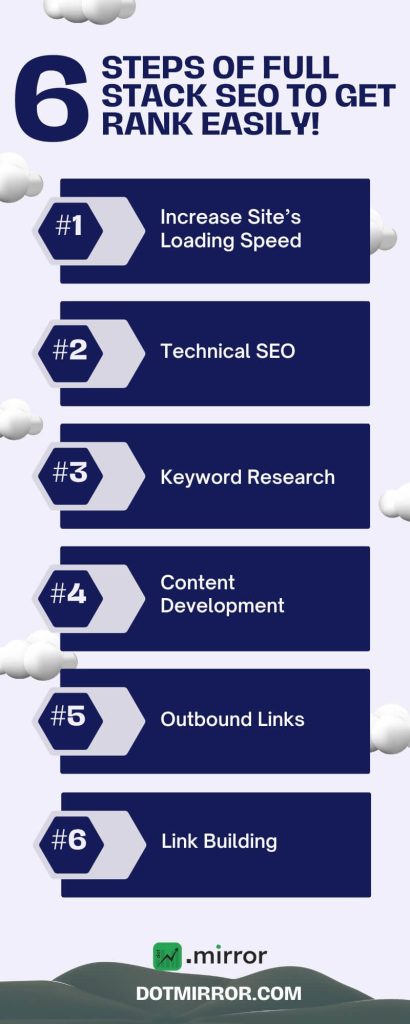Another way, SEO is the process of developing the site’s visibility when people search for products or services related to the business.
Experts adopt many optimization tactics to rank high in search results. Some immediate examples are keyword research, link building, improving page speed, etc.
Full stack SEO comes from the name “full stack developer” who is known as a website developer as well. They are able to perform code for the back-end and front-end of the website. However, in the terms of marketing, there are not many full-stack SEO experts.
A full-stack SEO expert is capable of maintaining the elements of SEO at an advanced level. It is more than getting the traffic. It is about finding the right customer via search engines or social media platforms.
The step-by-step action plans to rank higher in Google as a full-stack SEO expert include:
1. Increase Site’s Loading Speed
Google has publicly confirmed that Website loading speed has an impact on search engine ranking. Most people think that Google ranks you for having a fast-loading website. But that is simply not true.
Google actually penalized a slow-moving website. No need to mention that everyone hates slow-loading websites. Once you have increased the ranking speed you will be on the part with most other pages of the internet.
To improve the site’s loading speed:
- Go to Google page speed insight
- Enter the URL of an internal page of your website that gets a lot of traffic
- Press “Analyze”
As a result, Google will show you where your page’s code could use a tune-up. Though the site is helpful it doesn’t measure the site’s loading speed. There are several online tools to measure the site’s loading speed are:
- Sematext
- Pingdom Speed Test
- Uptrends
- WebPageTest etc.
2. Technical SEO
You might have the best content but if the website is having vital technical issues it is not going to rank on the search engine. Credit goes to Google, it has shown us the way. All you need to do are:
- visit Google search console, Have a look at the “Crawl Errors” section
- If you can see any issues like DNS, Server connectivity, Robots.txt fetch these indicate there are technical issues that have to be solved immediately
- If it shows green check marks in all of them then it means there are no issues anymore
- Click on the Crawl Errors section. It is not a matter of being afraid to have a few errors of Server error and in Soft 404. But if it indicates too many issues that is the fact you should be concerned about.
3. Keyword Research
Keyword research is the foundation of SEO. It is a process of generating words and phrases that online users keep searching for.
Keywords are compared as a compass for SEO campaigns. They suggest to you where to go and whether you are making progress or not.
There are ways to search for keywords. Explaining some steps that will assist to get keywords easily.
Step 1 – Google Search
Write a niche that you want to have keywords for on Google search. Don’t type “Enter”. You will see Google will suggest many keywords that lots of people search for.
Step 2 – Ubersuggest tool
It shows hundreds of Google suggest keywords in one place. So finding keywords would be easier from this particular tool.
Step 3 – SEMrush
It’s a widely accepted keyword research tool used by experts. Instead of providing the seed keywords, you can provide the competitors’ website addresses in it and as a result, it shows all of the keywords your competitors used to rank.
4. Content Development
A few days earlier Google used to provide value to the website which had many unique contents.
However, this particular theory does not work anymore. Nowadays, Google aims to show their user the best result for a given keyword.
That means Google doesn’t care how many pieces of content your site holds and how frequently you post them. Here, Google considers how much amazing content you have on your site.
Tips for how to create great content
- Practical content has 34% more statistics than content that has less practical information.
- Content should be 1800 plus words long
- Create info-graphics
- Include your targeted keyword once in the first 100 words of your content. This is because Google put more weight on the keyword that appears at the top of your page.
5. Outbound Links
Outbound links are links that point from your website to another’s website. Google’s algorithm considers outbound links to authoritative sites and holds positive impacts.
People are aware that internal links are the secret key to many SEOs and that they can be helpful to boost organic rankings as well as visibility.
Optimizing the outbound links, however, has one of the fundamental impacts to rank higher in SERPs.
6. Link Building
The work begins after developing the content. There are several ways to build links on your website. For instance; Broken Link Building which includes three steps,
- Find a page you wish to get a link from
- Find broken links on that particular page
- Inform the site owner about their broken links
You may use email as a mode of communication. There are lots of standard samples of emails to build links.
Final Thoughts
Every SEO strategy is unique. The above-mentioned full-stack SEO solution techniques will take you in a variety of directions.
It’s your choice whether you decide to focus on content optimization or page speed, you can develop your SEO. If you need some assistance & solution with your SEO strategy Dot Mirror can always help.






